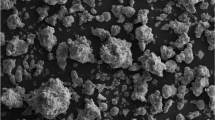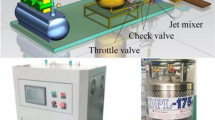Abstract
Use of a high-pressure coolant supply (HPC) can lead to a considerable improvement in machining performance and process stability during the cutting of difficult materials such as stainless steels. Due to the high pressure of the coolant jet, a hydraulic wedge was formed at the tool–chip interface and thus reduced tool–chip contact length and friction behavior. Moreover, the cutting stability can be enhanced as a result of efficient chip breakability. The goal of this work is to evaluate how chip morphology is influenced by three thin jets of pressurized coolant directed into the tool–chip interface during machining of AISI 304 austenitic stainless steel and compare the resulting performance of the tool with dry and conventional coolant conditions. Furthermore, this research evaluates the influence of tool wear on the chip forming mechanism during the turning process. An analysis of the chip generated under machining emphasizes the hypothesis that variations in the cutting tool wear directly affect the chip shape and type of chip segmentation. Finally, a theoretical model was developed to predict the chip upcurl radius under HPC machining. This model is based on shear plane and structural mechanical theories which evaluate plastic strain and the bending moments along the length of the curled chip. The chip upcurl radius values from the developed theoretical model were found to be in good agreement with those measured in the machining tests.
Similar content being viewed by others
References
Xavior MA (2012) Evaluating the machinability of AISI 304 stainless steel using alumina inserts. J Achiev Mater Manuf Eng 55:841–847
Gariani S, Shyha I, Inam F, Huo D (2017) Evaluation of a novel controlled cutting fluid im**ing supply system when machining titanium alloys. Appl Sc 7:560
Rahman M, Senthil Kumar A, Choudhury MR (2000) Identification of effective zones for high pressure coolant in milling. CIRP Ann Manuf Technol 49:47–52
Mia M, Dhar NR (2018) Effects of duplex jets high-pressure coolant on machining temperature and machinability of Ti-6Al-4V superalloy. J Mater Process Technol 252:688–696
Liu E, Han R, Tan G, Li Z (2006) Analysis of chip breaking prediction in cutting aluminum alloys. Mater Sci Forum 532:213–216
Kaminski J, Alvelid B (2000) Temperature reduction in the cutting zone in water-jet assisted turning. J Mater Process Technol 106:68–73
Kubala Z (1989) Metal machining with high- pressure water-jet cooling assistance—a new possibility. J Eng Ind 111:7–12
Courbon C, Sajn V, Kramar D, Rech J, Kosel F, Kopac J (2011) Investigation of machining performance in high pressure jet assisted turning of Inconel 718: an experimental study. J Mater Process Technol 211:1834–1851
Palanisamy S, Townsend D, Scherrer M, Andrews R, Dargusch MS (2009) High pressure coolant application in milling titanium. Mater Sci Forum 618:89–92
Machado AR, Wallbank J, Pashby IR, Ezugwu EO (1998) Tool performance and chip control when machining Ti6A14V and inconel 901 using high pressure coolant supply. Mach Sci Technol 2:1–12
Guidance UT (2005) An analysis of strain in chip breaking using slip-line field theory with adhesion friction at chip / tool. J Mater Process Technol 170(1):509–515
Joshi SS, Ramakrishnan N, Ramakrishnan P (1999) Analysis of chip breaking during orthogonal machining of Al/SiCp composites. J Mater Process Technol 88(1):90–96
Henriksen Ek (1954) Chip breaker dtudies I: design and performance of ground chip breakers, Engineering Reprint Series Reprint Number 12 The University of Missouri Bulletin, Missouri
Okushima K, Minato K (1959) On the behaviour of chip in steel cutting. Bulletin JSME 2(5):58–64
Sandvik Coromant (2017) Turning tools, Switzerland
Koyee RD, Schmauder S, Heisel U, Eisseler R (2015) Numerical modeling and optimization of machining duplex stainless steels. Prod Manuf Res 3:36–83
Panda A, Duplák J, Vasilko K (2012) Analysis of cutting tools durability compared with standard ISO 3685. Int J Comput Theory Eng 4(4):621–624
Shaw M (2005) Metal cutting principles, 2nd edn. Oxford Unversity Press, New York
ISO (2000) ISO 5436-1:2000 (en): Geometrical product specifications (GPS)—surface texture: profile method, Measurement standards–part1, Geneva, Switzerland
Shivpuri R, Hua J, Mittal P, Srivastava AK, Lahoti GD (2002) Microstructure-mechanics interactions in modeling chip segmentation during titanium machining. CIRP Ann 51(1):71–74
Mia M, Dhar NR (2015) Effect of high pressure coolant jet on cutting temperature, tool wear and surface finish in turning hardened (Hrc 48) steel. J Mech Eng 45(1):1–16
Abukhshim NA, Mativenga PT, Sheikh MA (2004) An investigation of the tool-chip contact length and wear in high-speed turning of EN19 steel. Proc Inst Mech Eng B J Eng Manuf 218(8):889–903
Wan ZP, Zhu YE, Liu HW, Tang Y (2012) Microstructure evolution of adiabatic shear bands and mechanisms of saw-tooth chip formation in machining Ti6Al4V. Mater Sci Eng A 531(1):155–163
Habak M, Lou Lebrun J (2011) An experimental study of the effect of high-pressure water jet assisted turning (HPWJAT) on the surface integrity. Int J Mach Tools Manuf 51(9):661–669
Haddag B, Makich H, Nouari M, Dhers J (2015) Characterization and modelling of the rough turning process of large-scale parts: tribological behavior and tool wear analyses. Procedia CIRP 31(1):293–298
Bi XF, Sutter G, List G, Liu YX (2009) Influence of chip curl on tool-chip contact length in high speed machining. Mater Sci Forum 626(1):71–74
Molinari A, Musquar C, Sutter G (2002) Adiabatic shear banding in high speed machining of Ti-6Al-4V: experiments and modeling. Int J Plast 18(1):443–459
Miguèlez MH, Soldani X, Molinari A (2013) Analysis of adiabatic shear banding in orthogonal cutting of Ti alloy. Int J Mech Sci 75(1):212–222
Barry J, Byrne G (2002) The mechanisms of chip formation in machining hardened steels. J Manuf Sci Eng 124(3):528–545
Sima M, Özel T (2010) Modified material constitutive models for serrated chip formation simulations and experimental validation in machining of titanium alloy Ti-6Al-4V. Int J Mach Tools Manuf 50(11):943–960
Da Silva RB, MacHado AR, Ezugwu EO, Bonney J, Sales WF (2013) Tool life and wear mechanisms in high speed machining of Ti-6Al-4V alloy with PCD tools under various coolant pressures. J Mater Process Technol 213(8):1459–1464
Gajrani KK, Sankar MR (2017) ScienceDirect state of the art on micro to nano textured cutting tools. Mater Today Proc 4(2):3776–3785
Khan MA (2015) Effect of high pressure coolant jets in turning Ti-6al-4v alloy with specialized designed nozzle. Dissertation, Bangladesh University of Engineering & Technology Dhaka
Jawahir IS (1990) On the controllability of chip breaking cycles and modes of chip breaking in metal machining. CIRP Ann Manuf Technol 39(1):47–51
Wang B, Liu Z (2016) Evaluation on fracture locus of serrated chip generation with stress triaxiality in high speed machining of Ti6Al4V. Mater Des 98(1):68–78
Skrzypek J, Ganczarski A (1999) Modeling of material damage and failure of structures. Theory and Applications, London
Nakayama K, Arai M, Kanda T (2011) Machining characteristics of hard materials. Mach Hard Mater 37(1):1–21
Zhou L (2011) Machining chip-breaking prediction with grooved inserts in steel turning, dissertation, Worcester Polytechnic Institute
Buchkremer S, Schoop J (2016) A mechanics-based predictive model for chip breaking in metal machining and its validation. CIRP Ann Manuf Technol 65(1):69–72
Devotta A, Beno T, Löf R, Espes E (2015) Quantitative characterization of chip morphology using computed tomography in orthogonal turning process. Procedia CIRP 33(1):299–304
Merchant ME (1945) Mechanics of the metal cutting process. II. Plasticity conditions in orthogonal cutting. J Appl Phys 16(1):318–324
Astakhov VP, Shvets SV, Osman MOM (1997) Chip structure classification based on mechanics of its formation. J Mater Process Technol 71(2):247–257
Buchkremer S, Klocke F, Lung D (2015) Finite-element-analysis of the relationship between chip geometry and stress triaxiality distribution in the chip breakage location of metal cutting operations. Simul Model Pract Theory 55(1):10–26
Buchkremer S, Klocke F, Lung D (2014) Analytical study on the relationship between chip geometry and equivalent strain distribution on the free surface of chips in metal cutting. Int J Mech Sci 85:88–103
Nomani J, Pramanik A, Hilditch T, Littlefair G (2017) Stagnation zone during the turning of Duplex SAF 2205 stainless steels alloy. Mater Manuf Process 32(13):1486–1489
Klocke F, Sangermann H, Krämer A, Lung D (2011) Influence of a high-pressure lubricoolant supply on thermo-mechanical tool load and tool wear behavior in the turning of aerospace materials. Proc Inst Mech Eng B J Eng Manuf 225(1):52–61
Çolak O (2012) Investigation on machining performance of Inconel 718 under high pressure cooling conditions. Stroj Vestn-J Mech Eng 58(11):683–690
Kamruzzaman M, Dhar NR (2008) The effect of applying high-pressure coolant (HPC) jet in machining of 42crmo4 steel by uncoated carbide inserts. J Mech Eng 39(2):71–77
Ezugwu EO, Bonney J (2004) Effect of high-pressure coolant supply when machining nickel-base, Inconel 718, alloy with coated carbide tools. J Mater Process Technol 153(1):1045–1050
Zhou L, Rong Y, Li Z, Yang JA (2003) Development of web-based machining chip breaking prediction systems. Int J Adv Manuf Technol 22(5):336–343
Zhang YZ, Peklenik J (1980) Chip curl, chip breaking and chip control of the difficult-to-cut materials. CIRP Ann Manuf Technol 29(1):79–83
Acknowledgments
This research was supported by Natural Sciences and Engineering Research Council of Canada (NSERC) under the CANRIMT Strategic Research Network Grant NETGP 479639-15.
Author information
Authors and Affiliations
Corresponding author
Rights and permissions
About this article
Cite this article
Seid Ahmed, Y., Paiva, J.M. & Veldhuis, S.C. Characterization and prediction of chip formation dynamics in machining austenitic stainless steel through supply of a high-pressure coolant. Int J Adv Manuf Technol 102, 1671–1688 (2019). https://doi.org/10.1007/s00170-018-03277-7
Received:
Accepted:
Published:
Issue Date:
DOI: https://doi.org/10.1007/s00170-018-03277-7




